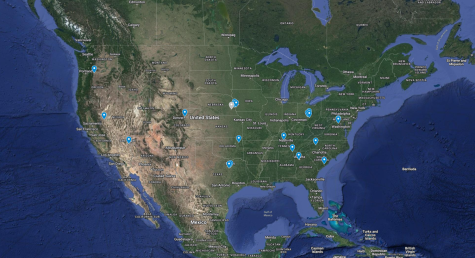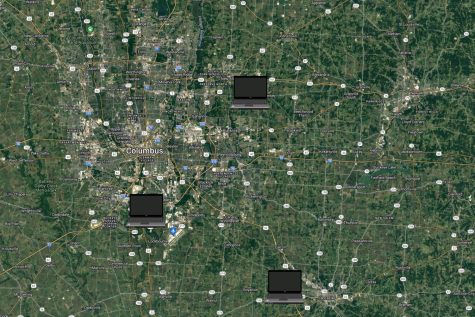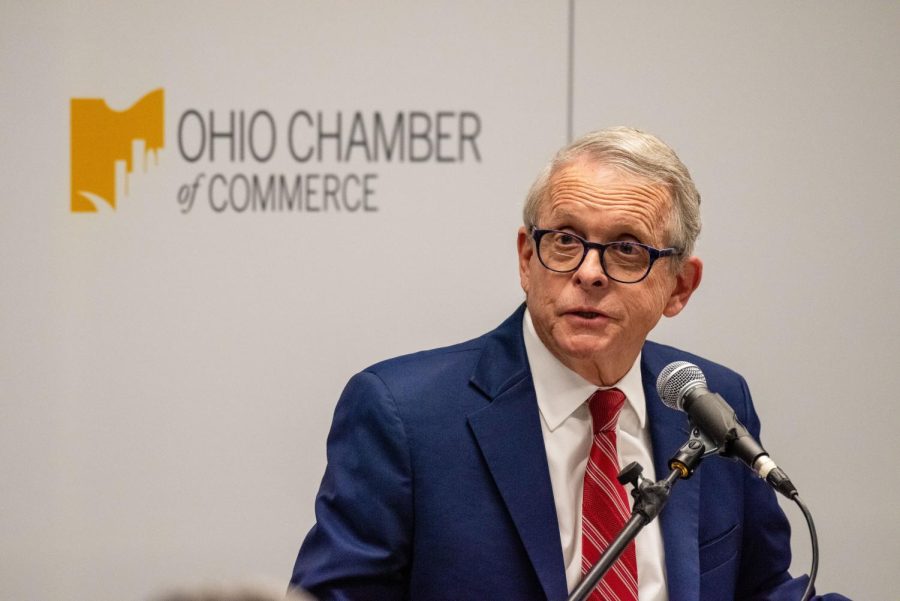Google announces additional data centers in Central Ohio, officials celebrate investment
Governor Mike DeWine speaks at the Ohio Chamber of Commerce in which Google announces the deployment of two additional data centers to Central Ohio.
May 9, 2023
Representatives with Google and officials from across the state recently came together in downtown Columbus at the Ohio Chamber of Commerce, in the former Columbus Dispatch Building, to recognize the historic investment of two additional data centers by the tech giant in the Buckeye State.
Central Ohio has positioned itself as the next Silicon Valley in recent years, dubbed the ‘Silicon Hearthand,’ as other tech leaders such as Amazon and Facebook have also deployed data centers in the region. In early 2022, Intel announced they were coming to the state with a pledged initial $20 billion dollar investment to construct two leading-edge chip factories, reshoring the manufacture of computer chips deemed critical to national security and the domestic economy.
At an event held earlier this month, the announcement that Google would be deploying two additional data centers in the region, one in Lancaster and one in Columbus, was met with praise from government and business leaders alike.
Elected leaders from the state’s executive branch, members of Congress, local Statehouse representatives, area mayors and many others echoed one another that the continued investment by many tech giants has and will continue to profoundly change Ohio’s place in the new digital economy.
“It’s a huge announcement for Ohio, one in a series of great announcements in the past few years,” said State Senator Tim Schaffer of the 20th District, who represents the territory of Google’s new data center in Lancaster and also the massive sprawling tech site in western Licking County home to Google, Facebook, Amazon and soon Intel as well as its many manufactures. “This is the rebirth of an industrial state into the new modern economy.”
Schaffer says industry leaders choosing Central Ohio as they expand their domestic footprints and reshore their critical manufacturing back to the continental United States is a win not just for the economy but gives hope to students that high-paying jobs are here and many more are ‘just on the horizon.’
“Don’t think this is the last announcement we are going to have,” Schaffer said smiling.
Ohio House Speaker Jason Stephens, a representative from rural southeast Ohio, was also in attendance for the announcement. Stephens has been instrumental in the legislature along with former local Representative Brian Stewart at expanding rural broadband with plans for near-ubiquity of high-speed internet coverage in the coming years with billions of dollars of both state and federal allocations being deployed at this very moment to make that goal a reality.
As Y-City News has previously reported, multiple fiber backbone providers have crossed rural Ohio in recent years with 288-strand fiber optic cables – officially capable of at least hundreds of terabits per second.
“The future of Ohio is extremely bright, it’s exciting to see an announcement of this magnitude,” said Stephens. “It’s great for all parts of the state, not just Central Ohio but those in the surrounding areas that will benefit from the eventual spin-offs.”
U.S. Representative Troy Balderson, of the 12th Congressional District, an invited speaker at the announcement, spoke about Google’s investments in the regions it deploys to, including as he detailed, the promotion and financial support of various 4-H projects and programs in Ohio.
“It’s very special, its differential change for our Appalachian community’s kids,” said Balderson, whose district, like Schaffer’s, covers both the Lancaster site as well as the mega tech site in western Licking County. “With these developments, they now have opportunities that a lot of kids didn’t have growing up.”
Balderson noted it’s also not just the tech industry coming to Ohio, citing Amgen’s deployment of a new biomanufacturing plant in Central Ohio that will bring high-paying jobs on top of its $365 million investment in the region.
Developments such as Intel would not have been possible without federal support in the way of the CHIPS Act which recognizes both the national security and domestic economic need for cutting-edge computer chips being produced in the continental United States, protected against disruptions by foreign adversaries, such as China.
Like Speaker Stephens, Balderson, who has devoted significant time and resources to rural broadband throughout his career, said the deployment of the many data centers in Central Ohio would benefit residents across the state by increasing broadband access via additionally deployed fiberoptic lines.
“It’s a big blessing because it seems like we’ve been talking about it since 2007,” said Balderson. “We are seeing movement now and we are really excited about that, we are going to push to continue that development.”
As for if more announcements are on the horizon, Balderson said Ohio has a lot of talent and that we have the land and water to accommodate many more developments, developments that bring high-paying jobs and massive economic investments into the region.
“We are going to continue to grow,” said Balderson. “Look at what Intel is going to bring and the many manufacturers that have already committed to follow, look at Honda and the many suppliers across the state that support that facility.”
Representatives with Google say that the total investment of their three data centers in Central Ohio will bring its economic investment in the Buckeye State to more than $2 billion.
Typically, Google operates a single data center site when they deploy to a new state. If the company chooses to expand, they do so on the already existing campus.
According to Google, the company has 14 data center locations in the United States. The company’s first data center, located in Oregon, for example, has been expanded many times on the same campus.

Only in four instances does Google have data centers in the same geographic region but separated by multiple miles of distance.
Two of those data center locations, the pairs in Texas and the pairs in Virginia, each have facilities separated by roughly 16 miles and eight miles, respectively.
Of the two remaining regions, one is located in greater Omaha, Nebraska, a location that features many secretive as well as classified military and national security programs, and the other is now the trio being deployed in the greater Central Ohio area.
Around Omah, there are four Google data centers, three of which are roughly 15 miles apart and form a triangle of equal separation. In Ohio, the three sites also form a triangle of equal distance from the other two, but at a rough distance of 20 miles.
Google has not given a public reason why they opted to build the Columbus and Lancaster data centers on separate campuses while the New Albany site has what appears to be ample room for additional expansion, as Facebook has opted to do, building their now sprawling campus south.
According to federal filings, Google’s New Albany data center will also be the company’s first location in the world to feature Starlink ground terminals.

The region, for example, is home to Boeing’s Guidance Repair Center in Heath, in central Licking County, which is responsible for ‘maintaining the readiness and modernization of guidance and navigation systems for our nation’s nuclear-capable platforms as well as non-nuclear capable guidance and control systems, electronics and radio frequency systems and platform processes.’
According to Boeing, the site is the ‘second most geological stable point in the United States after the Cheyenne Mountain in Central Colorado.’ That feature, which extends to western Licking County, is significant for many reasons, including being very beneficial in the manufacturing of computer chips, which require the utmost stability as transistors are 10,000 times smaller than the width of a human hair, which will also be aided by a sizable foundation to protect against natural ground vibrations.
During the Intel announcement, seated in the audience but not specifically recognized, was FBI Special Agent in Charge J. William Rivers, of the Cincinnati Field Office, whose territory covers the entire Southern District of Ohio, including the mega tech site in western Licking County.
As foreign adversaries, such as China, have been cut off from many of the tools necessary to produce cutting-edge computer chips needed in the new modern economy, the country, unable to compete against America’s talent and technological prowess, has resorted to activities not seen at scale in the homeland since the first Cold War against the Soviet Union. In response, assets have been deployed to protect and ensure industry secrets aren’t stolen, including by proxy of compromising officials throughout the greater region.
The Department of Defense employs the Trusted Foundry Program which coordinates with those in the private sector to ensure a domestic production base for chips needed for military applications. Those chips are used in military systems, generally used in secret programs, or for application-specific uses such as radiation-hardened devices for use in space or nuclear conflict.
Numerous officials, throughout the past years, have echoed in off-the-record conversations, that many additional developments are expected in Central Ohio that will significantly advance the region as a technological powerhouse for decades to come.
In the interest of national security and to protect critical infrastructure, some specific details and information has been limited or withheld entirely, including active measures to protect against foreign espionage.














